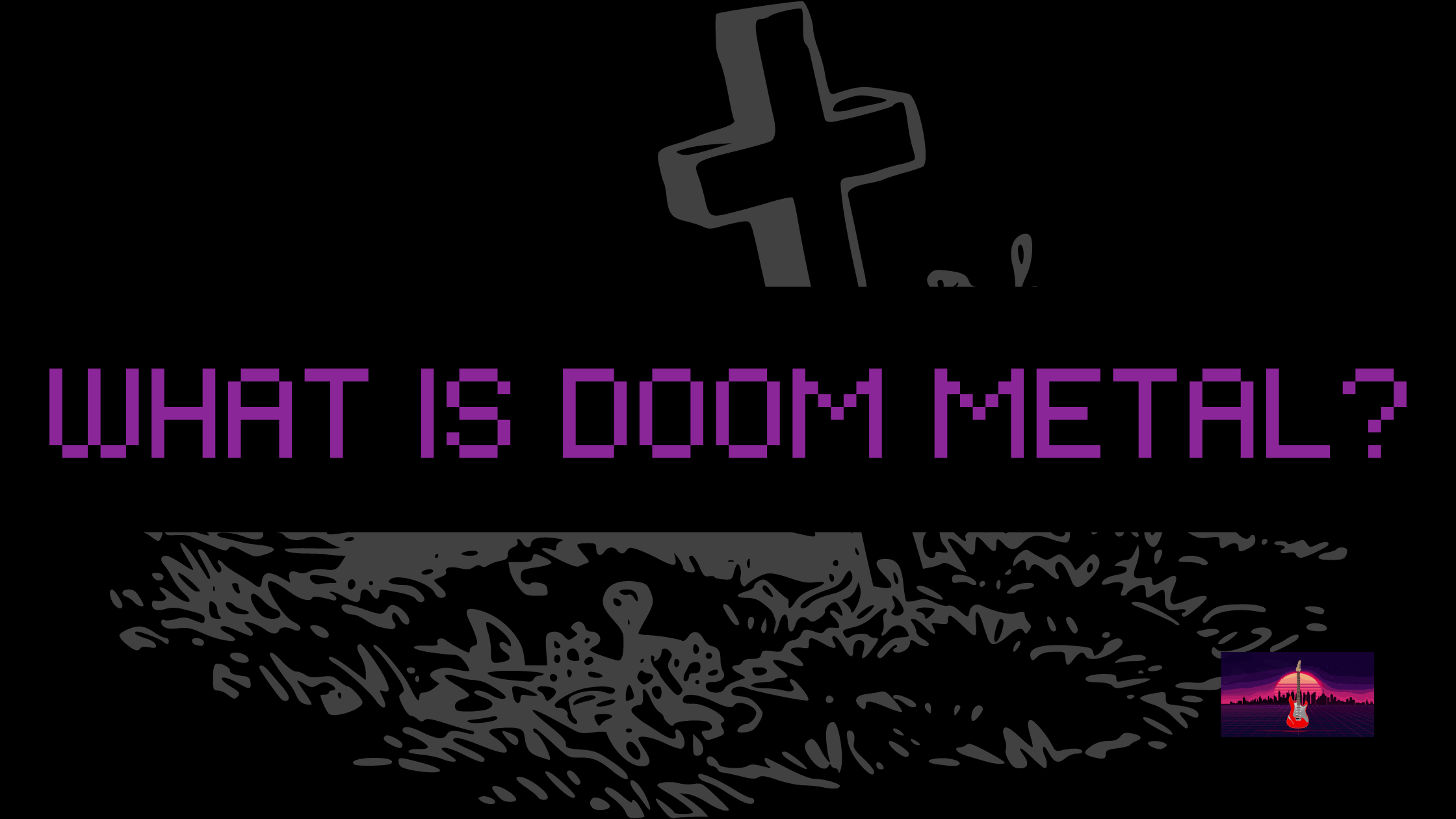Have you ever come across the term “Doom metal”?
This term is used to describe one of the extreme subgenre of metal music, that heavily focuses on a slow tempo, as well as heavy chords, a very melodic component and a big focus on the bass and the instrumental.
It is also often grouped together with other subgenres such as black and death metal and sometimes with stoner metal, but beyond those this style is very particular and also easily recognisable, thanks to the very dark tone (both in the instrumental parts and in the lyrics, that try to communicate a sense of doom, as the name itself says, and despair, with topics such as drugs, religious images, apocalyptic scenes, horror and also epic stuff but in a darker way than power metal and other epic genres).
Other common themes are also related to mental illness (paranoia and depression), burst of emotions such as anger and melancholy and in general a pessimistic view of life.
In short, we can definitely answer one of the first questions when you hear about this obscure genre, “is doom metal extreme?”, with a loud “hell yeah”.
HISTORY OF THE GENRE
THE EARLY ROOTS
This metal subgenre is universally recognised as a style started by Black Sabbath, considered pioneers of the heavy metal genre as well, that took the blues guitar style and added a dark nuance and feel.
As for heavy metal, though, Black Sabbath wasn’t considered nothing more than hard rock at the time, because the distinction and the definition would have come only later: for this reason, their music is considered a heavy (pun intended) influence for the birth of the doom genre, as well as the metal music in general.
THE FIRST RECOGNISED DOOM BANDS
The label of this genre (and also the distinction as a different and independent act) appeared only in the 80’s (or, better said, from late 70’s as well) thanks to the bands that are now considered the first in this subgenre: Trouble, Saint Vitus, Candlemass (with their breakthrough album “Epicus Doomicus Metallicus”), Pentagram and Witchfinder General.
This decade was the time when the foundations and the standard of this sound were born, and is now called “traditional” doom metal (or also only doom metal, as it is the subgenre in its core, with a style that was still similar and influenced by Black Sabbath’s peculiar sound).
FAR FROM THE ORIGINS
As most things, after a first period of tradition and “classic”-styled stuff in this genre, things started to become more experimental and branching into lots of different areas in the 90s (but after all, this isn’t 100% true as also the Sabbath and the first band were also experimenting and driving far away from their hard-rock/blues rock roots, as the first ones experimenting in that).
One of the first bands experimenting with new elements was the band Cathedral, that mixed more groovy elements to the slow playing of the genre.
Beyond them, in the 1990’s there was the birth of death/doom , that mixed elements of death metal such as growls and harsh vocals into the slow, dark and heavy sound of the genre (where most of the singers were using mostly clean vocals in the songs).
One of the first bands incorporating those elements was Winter, a name that was later grouped into the “big names” of this branch together with Anathema, My Dying Bride and Paradise Lost, that used a more poetry-themed imagery and romantic elements (as in the meaning of the romantic and also tragic literature of 1800s) and also focusing more on melancholy.
But this even darker and slower music wasn’t enough though, and more extreme genres were born as well: one of those extreme-beyond-the-extreme was funeral doom, that was even slower and darker, with the instrumentals being heavily influenced and becoming similar to a guitar ambient act but way, way darker.
Some big funeral bands were “Funeral” (first place in the list thanks to their easy to remember name), “Skepticism”, “Thergothon” and “Until Death Overtakes me”.
After all those first types of experiments, a lot more new fusions were born.
But how many different variations are there on this theme?
SUBGENRES OF DOOM METAL
There are a lot of different subdivisions in this genre, kinda connected (as for a lot of bands the elements of each one are kinda mixed with other influences as well) but still recognisable as a different area.
The main ones are:
| GENRE | CHARACTERISTICS | FAMOUS BANDS |
| Traditional/classic | The first, “original” type, with usually faster tempo and also mostly with clean vocals | Black Sabbath were the “founder” of this genre; similar bands are Candlemass, Saint Vitus, Pentagram in the traditional subgenre. |
| doom/death | A mix of both: the themes are the same but we have more screams and growls as vocals (together with clean ones) and the pace is slower with more distorted and crunchy guitar sounds. | Anathema, My Diying Bride, Evoken, Paradise Lost |
| Funeral | If the genre above is a more brutal version of the first one, the funeral variation is definitely the natural evolution of death one: here we have even slower tempo, with usually even darker song lyrics and vocals that can be as guttural as you can imagine and sometimes hardly understandable as well, giving a very unsettling overall feeling. | Funeral, Thergothon, Skepticism, Until Death Overtakes Me, Shape of Despair, Ahab |
| Stoner | One of the first defined subgenres, here the common theme is weed and other drugs, but from a dark and negative point of view. | Cathedral, Electric Wizard, Sleep |
| Drone | Even slower than funeral (hard to believe, right?), this is full of droning guitar sounds and minimalist walls of sounds, with little vocals or also totally without them and only very distorted instrumental parts. | Moss, Nadja, Burning Witch |
| Sludge | Dirty and groovy, this usually has lots of feedbacks and noises and some common elements with hardcore punk as well in the mix. | EYEHATEGOD, Iron Monkey, Grief, Crowbar, Corrupted, Negative Reaction |
| Gothic | Slow and heavier version of gothic metal, with gothic themes and also elements from classic music and epic metal as side element. | The Sins of Thy Beloved, Sirrah, Type O Negative, Virgin Black. |
| Progressive | As the name says, here you can find lots of musical virtuosity instrumentals and more experimental time signatures and songwritings. | King Goat, Below the Sun, Sierra, Oceans of Slumber, and Green Carnation |
| Black/blackened | Blackened doom is a subgenre of doom with very brutal instrumentals (and also lots of fast parts and solos) typical of black metal with the despair and themes of this genre | Morast, Faustcoven, the Ruins of Beverast, Bolzer, Necros Christos, Harvest Gulgaltha, Dragged into Sunlight, Hands of Thieves, and Soulburn |
IS DOOM ALSO STONER METAL?
Despite having a subgenre called stoner, they’re different because in stoner metal the drugs, weeds and other farmaceuticals are seen in a chill and also positive light (as a feel-good thing), but in the doomer perspective drugs are seen as just another manifest of paranoia and despair, as well as destructive.
USEFUL RESOURCES
- Does It Doom? (Youtube Channel and website);
- r/Doom (Reddit Community)
RELATED ARTICLES
- Easy songs for this subgenre
- good amps and pedals for doom music (combo and tube amps, fuzz pedals and distortions)

